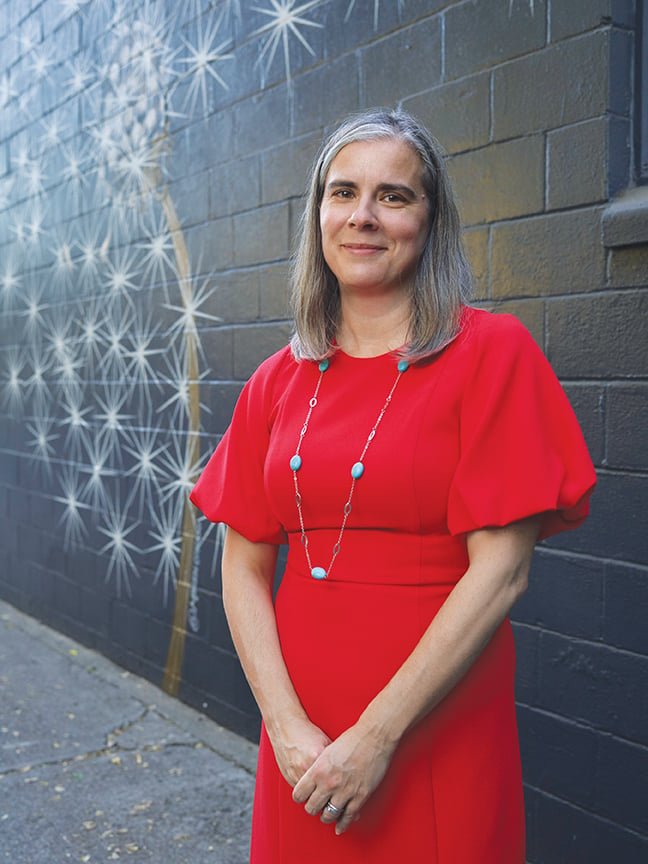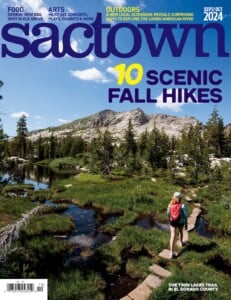Q&A: Sacramento’s Creative Economy Manager Megan Van Voorhis
Growing up in Flint, Michigan, Megan Van Voorhis wanted to be a ballerina like the one she saw twirling on an episode of Sesame Street. It wasn’t until she took a business administration class in college that she realized her calling wasn’t to make art, but to make art possible. As the head of Arts Cleveland, she introduced innovative programs linking art with health care and helping creators access their inner entrepreneurs. As Sacramento’s freshly appointed Cultural and Creative Economy Manager, the former dancer takes the stage for her next act. Here the new 916 resident talks about the arts’ influence on the GDP, how to reopen venues safely in the age of Covid, and why the ability to create is a basic human right.

Tell us a little bit about Arts Cleveland, where you spent nearly 20 years—most recently in the position of president and CEO—before moving to Sacramento in September.
Arts Cleveland is an organization that carries out advocacy work on behalf of the arts and cultural sector in Cuyahoga County, and provides direct service to the arts and culture community—counseling to individual artists and organizations on program development, strategic planning, business development.
I’ll give you an example: Archie Green is a hip-hop artist who suffered from depression for some period of time. We provided a lot of counseling to Archie and served as his fiscal sponsor. That allowed him to start doing mental health work in Cleveland, understanding that in the Black community there’s stigma around mental health and around bipolar disorder. He’s starting his own nonprofit now. His organization is called Peel Dem Layers Back, which came from a song he [wrote] that was about coming to terms with his depression. He does shows that [combine] hip-hop and conversations with people in the mental health community to try to reduce that stigma associated with getting help.
Your new title is Cultural and Creative Economy Manager. What is the creative economy and why is it important?
This is where data is really helpful. People care about the economy, and the creative economy itself is 4.5% of the GDP in this country. It’s bigger than agriculture, numbers-wise. The creative economy encompasses a lot if you look at it from a workforce perspective. There’s creative production happening through various vehicles. It could be an individual artist, a collective, a for-profit business or a nonprofit. You have the creative industries you might traditionally think of: theaters, music venues, art galleries, museums, cultural attractions. In addition to that, there are designers, industrial designers, graphic designers, fashion designers, architects, event producers, filmmakers and animators. It also impacts other parts of the economy—restaurants, travel and tourism. Then you also have creative workers who are working in other industries, like a graphic designer who works for a health care company.
I’ll be working to bring to life the [city’s] Creative Edge plan, which got adopted in 2018 and has a specific focus on developing the creative economy. Part of my role is figuring out what to elevate from that plan right now, to prioritize where we want to focus in light of Covid-19.
In fact, at Arts Cleveland you helped set up an emergency fund for artists affected by the pandemic.
Most artists are packaging together a living three or four different ways. They’re teaching lessons, they’re gigging, they might be adjuncts at a university, they might be making their own work. My brother is a musician and a K-8 music educator in a charter school. So for artists, in particular, it’s really hard now.
We went to the NoteWorthy Federal Credit Union—which is focused on filling the gap in creative capital and got its start doing musical instrument loans—and said, “What can we do to get access to capital for artists?” We ended up doing an emergency loan fund where the interest was subsidized by [a local] family foundation.
What is Sacramento doing on that front?
I think Mayor Steinberg is leading the way in having chosen to invest in creative assets at this time, using funds that Sacramento got from the Feds. The team is doing an outstanding job of getting those dollars out [through the city’s Creative Economy Recovery Grants]. The total allocation was $14.4 million.
Arts funding can be considered controversial at a time when basic needs aren’t being met. What is your response to critics who don’t think government funds should be going to the arts?
I think it’s a very limited view, the idea that the arts are a luxury. First and foremost, creative vitality is critical. The United Nations actually considers the ability to create a basic human right.
The connection between arts and mental health is really strong. Cuyahoga County’s central hospital system, MetroHealth, has a project called SAFE—it stands for Students Are Free to Express. The objective emerged because of what they were seeing, that childhood experiences are a key predictor of whole student health. They’re helping kindergarteners understand emotion using the arts. Maybe it’s spoken word, maybe it’s making your own portrait. The program is a preventative measure to try to help them establish these healthy skills, not just as a response to trauma. There was a kid who participated in it and later at home saw her mother feeling sad and was able to articulate her feelings and say, “Why are you feeling that way?” Establishing these skills very early on is so critical when you think about mental health. There is a strong interest in seeing that sort of thing happen here in Sacramento.
During the pandemic, you’ve also held regular conference calls with artists to brainstorm ideas for ways to respond to the situation. Any creative outcomes from that effort?
The [online marketplace] Made Cleveland was something that got introduced through one of those monthly artist calls. It was started by an artist who had a desire to help people bring their work to market and build capacity without having to set up their own websites. It’s a great example of the kind of thing that’s really needed everywhere. Developing new models and new ways for people to be able to engage with crafts and other creative products is really important.
The reality is that folks are hurting. But they’re also innovating. I got a tweet from a Sacramento Ballet dancer who’s involved with the Capital Dance Project, and they’re doing such cool stuff on film. [For a recent digital series] they worked with a filmmaker and performed on-site around Sacramento. Some of their videos are really amazing. If you think creatively going into this, you’re going to see this as a moment to innovate. It’s a tough time, but it’s also an opportunity to move things forward.
What are some other areas of opportunity that you see for Sacramento?
Housing. One of the things that Cleveland has is a low cost of living. I had been working with an organization in the Collinwood neighborhood there to think about ways to do co-ops or collective ownership to provide affordable spaces. Out here, the costs are so high. How do artists afford to live here? If you want to have creative vitality, then the conditions facing your creative people become really important. If artists can get access to better things elsewhere, do we lose that talent? That’s a real challenge right now in the arts industry.
Another real challenge is tackling racial disparities in the arts world. What are your plans to address this issue?
A lot of us who work in this space are really just beginning to understand and bolster our own knowledge about what the history of America actually looks like. For me, growing up in Flint, I didn’t really get that education. I’ve done a lot of learning on racial equity in the arts and there’s still more to learn.
I can’t speak for a person of color, I’ve not had that experience, but at the same time, you can recognize the racialized dynamics. For example, how did the practice of redlining impact schools and segregation, and then how did that impact the resources and who has access to arts education programming?
Right now we have some demographic data we’re able to unpack: Arts Cleveland invested something like $3 million in 160 artists over an eight-year period, and it was a blind adjudication process—everything is stripped away, you don’t have resumes, you don’t have names, only the work. Despite those efforts, 71% of those artists were white. And we know that’s just not reflective of our population. When you apply a blind adjudication process on a racist system, you’re not going to get the kind of outcome that you’re looking for. So I think that self-study is really important, and then adjusting practice based on that. There’s a responsibility that we have for surfacing the disparities and then using that information to try to recruit folks who are not being supported.
What are your thoughts on the thorny issue of reopening performance venues?
I’ll be honest. It’s going to take some time for people to feel comfortable going out. I’ve been actively involved with the efforts—with NIVA [National Independent Venue Association] and with Music Cities Together—to reopen venues safely. People performing over multiple nights instead of one night, queuing apps for getting people in and out, things like that. Smaller [organizations] could program in larger venues, so you’re putting 300 people in a much larger space that allows you to socially distance. And drive-in concerts— drive-ins were petering out, and I think it’s a great time to bring those back to life.
In your initial explorations of Sacramento, are there things that have stood out to you—any artists or experiences?
The public art here is fascinating. There are a lot of dynamics in terms of how you fuse national and international work and connect it to a local scene. It’s definitely something that I see, and that is hugely exciting. And I’m very interested in uncovering the stuff that people aren’t talking about. I am going to be on a search for the city’s arts and cultural soul. It’s going to take some time to figure out because some of it is very visible and some of it is not.
I chose to live near midtown. My family drove around lots of different areas and the midtown vibe was really great. The walkability is just amazing, the restaurants—it’s all there. My youngest son, who is 12, plays electric guitar and bass, and has very much an interest in wanting to stay in the midtown area. My oldest, who is a high school junior, has an interest in biomedical engineering, so we decided to check out UC Davis, and when we went to the engineering quad, what stood out to me was that there was a design, art, craft facility right next to it. It was pretty cool because there’s a really strong connection between engineering and design. I was like, “Damn, you guys get it!”


